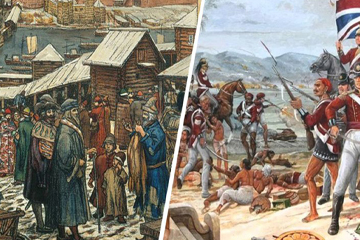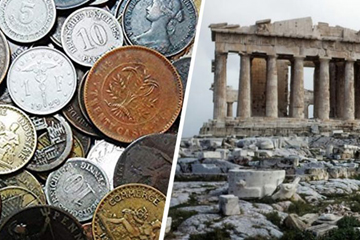In the last part, we looked at the rise of trade and the emergence of empires as the contributing factors towards the growth of banking. In this part, we will look at two other major factors that drove banking in the early parts of human history – wars and paper money.
The horror of wars
Empires were not built on dialogues and discussions. Along with tactical nous, they also needed strong-arm tactics and military might. Loyalty would not have been the only drug that propelled millions of soldiers to fight for their kings. Machines, weapons, cavalry, horses, chariots – all needed money to be built or to be maintained.
In the pre-historic age, when kings ruled with an iron fist, the king and a few religious leaders controlled the money of each state. In times of war, the king could always levy extra taxes. As nations grew, the distribution of wealth amongst its citizens became more widespread. The concept of ownership shifted from the concept of kingship to individualism. Kings and religious leaders were part of a large social ecosystem that contained people and corporations.
Around the 5th century AD, the Roman Empire collapsed and with it, the growth of the banking industry came to a standstill. Around the 12th century AD, the kings needed more money to facilitate their expansions, but they could not force people to pay more taxes for the kings feared revolutions.
The leaders needed one overpowering feeling that united people to contribute money. This overpowering feeling was faith. By the 12th century, after lying dormant for nearly 700 years, religious fervor stimulated the re-emergence of banking. Crusades were the stimulant. The Church needed hordes of money to facilitate their wars and banks came forward to finance these wars. Probably, the banks were forced to come forward. In some cases, bankers of Italy and other European nations were forced to lend money. Money was moved across nations to feed far-flung armies.
After several years, the Crusades stopped. But, the insatiable urge for kings to expand never came to an end. A great push to the modern-day banking came in 1797, when England, threatened by war, suspended cash payments through its central bank – The Bank of England. This move created panic and forced the Bank of England to create notes of the lower denomination which helped banking spread beyond nobles.
Wars also acted as the cause for the creation of central banks across many nations. In fact, most of the central banks were set up to facilitate the flow of money from the people and merchants to the government in times of war. For example, the War of the Second Coalition led to the formation of Banque de France, the French central bank, in 1800 AD. The aim of Banque de France was to improve the public financing for the war.
Probably Napoléon Bonaparte didn’t know, but he also played a critical role in the development of new-age banking knowingly or unknowingly. The Rothschild banking family had funded Napoleon’s major wars and colonial expansion, but their involvement with the war helped Rothschilds to get the information of Napoleon’s defeat much before the English forces thereby aiding them in investing their money in a proper manner.
The last great war of the modern era, the Great World War II, resulted in the creation of the International Monetary Fund and World Bank. Encouraged by these institutions, commercial banks started to lend to sovereign states in the third world. The US became the new global center of banking.
While wars brought with them great despair, the role of banks in rebuilding nations after the war has also been praiseworthy.
A war requires enormous financial resources but in the end, humanity suffers because of wars. From an independent point of view, the wars created the demand for large sums of money which could be satisfied through banks only. Was then wars unavoidable for banks to grow? For the scores who lost their lives through wars, it never looked necessary.
The growth of paper money
On November 8, 2018, the Government of India demonetized the notes of Rs. 500 and Rs.1000 of the Indian Rupee. In one night, what was once enough to buy a meal for a family of four for a week was just paper.
Yet, as the online magazine, Quartz pointed out, it was but a small moment in the history of money and banking, of which a significant moment was the invention of paper money.
Modern notes are not just pieces of paper, but promissory notes that promise to pay the bearer the denoted sum, but in a matter of minutes, these notes can become paper.
Earlier money came in all forms – grains, beads, weapons, cattle, etc. But it was difficult to carry around, tough to transact and even tougher to store. Counting in decimals was not even an option.
Gradually, coins came, and they solved most of the problems that the earlier forms of monies had. But they were still heavy. In fact, in China, copper coins were designed with square holes in the middle so that they could be carried around in a string. It worked, but it was tough. Imagine if you got your next salary with a sack of coins.
During the 7th and 8th centuries, trade was flourishing along the Silk Route. The Tang Dynasty was ruling China. Traders from China needed an easier way of storing their money as carrying around hundreds of coins was not an option. They deposited their money (or coins) with a trustworthy agent, who in return gave them a note which denoted how much money they had deposited with the agent. The traders could use the note for trade. While this was not technically a printed note, this did set a strong precedent.
In the early part of the 10th century in China, under the leadership of the Song Dynasty, the government licensed certain agents to issue these promissory notes and gradually the government took control of the system, printing the promissory notes themselves. They called it jiaozi. The Song dynasty established factories to print this paper money. They were even issued in multiple colors.
As ThoughtCo points out in their website, ‘In 1265, the Song government introduced a truly national currency, printed to a single standard, usable across the empire, and backed by silver or gold.’
But this amazing achievement was short-lived as the visionary Song Dynasty fell to the Mongols. While the succeeding dynasties tried to print currencies and even impressed the renowned traveler Marco Polo with the idea, the paper currency collapsed and was not to see the light of the day till 1890 when yuan was printed as paper currency.
But good ideas spread fast. Across the other end of the Silk Route, in Europe, the trade was growing, and the traders needed a convenient way of transferring large sums of money over large distances. The traders fell in love with the idea of promissory notes and started using it.
Here also, the promissory notes were the precursor to bank notes. In fact, the term bank note is also derived from the Italian word nota di banco which meant bench note.
While the first bank notes were issued by private lenders in Europe from the 14th century itself, it was not until 1661 that the first bank note was issued by a bank – by Stockholm’s Banco, the predecessor of Bank of Sweden. Sadly, the bank ran out of coins to redeem these notes and had to shut down in 1664. Call it an irony, but that is what happened.
In the United States also, while bank notes were issued by each of the thirteen colonies in the early 18th century, it was just one of the different currencies in circulation. It was not until 1933 that the bank notes were formally accepted as the preferred form of currency over other precious metals.
Paper money made handling money easier and banking more convenient. Paper money also introduced the concept of counterparty risk. Since paper is not always durable, we are now shifting to plastic money. Paper may be easy to counterfeit and not issuing the right amount of paper money can destabilize a nation, but paper money has saved precious metals, is easy to count and can be mass-produced with uniform quality. Would gold be considered so valuable if everyone had gold coins with them?
It is sure banks have greatly benefited from the invention of paper money and the modern banks must be thankful to the Tang Dynasty for this unique invention.
Paper money also helped drive an increase in trade which was one of the contributors for the industrial revolution, which further helped the banking industry grow.
In the final part, we will look at the factors that made banking the behemoth it is today – industrial revolution, globalization, and the rise of technology.


